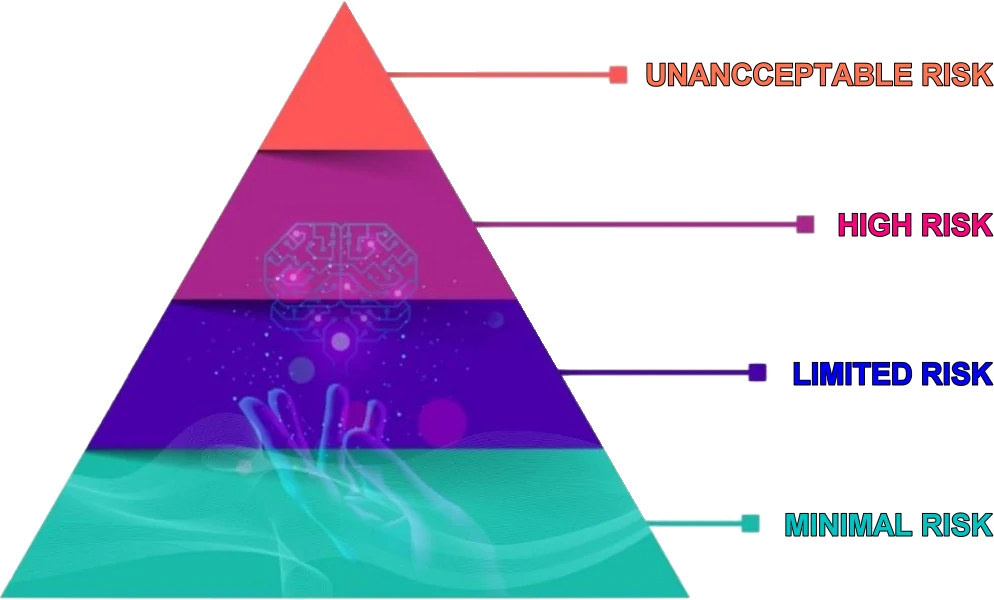7.12.2. Act with rules of Artificial Intelligence |
 The European Union will become the first region in the world to legally regulate artificial intelligence issues. Therefore, the author on this page has nothing to invent, but simply rewrite and possibly summarize what the competent EU authorities have already written. It is even better if he transcribes what has already been summarized, and for this purpose he copied the text from the IT magazine 'BUG', not to compete with them as the first author to accept it, but simply for the reason that the audience of the IT magazine 'BUG' is not the same as the audience that reads the pages from this site, so everything will be publicly available to those interested. The picture in the header of this paragraph, which they used in the text, is to be commended by everyone, thereby enriching women's emancipation and establishing UI as a female gender. The regulation was confirmed after marathon 37-hour negotiations between representatives of the Council and the European Parliament, during December 2023. From Brussels, they are already declaring that regulation historic.
The European Union will become the first region in the world to legally regulate artificial intelligence issues. Therefore, the author on this page has nothing to invent, but simply rewrite and possibly summarize what the competent EU authorities have already written. It is even better if he transcribes what has already been summarized, and for this purpose he copied the text from the IT magazine 'BUG', not to compete with them as the first author to accept it, but simply for the reason that the audience of the IT magazine 'BUG' is not the same as the audience that reads the pages from this site, so everything will be publicly available to those interested. The picture in the header of this paragraph, which they used in the text, is to be commended by everyone, thereby enriching women's emancipation and establishing UI as a female gender. The regulation was confirmed after marathon 37-hour negotiations between representatives of the Council and the European Parliament, during December 2023. From Brussels, they are already declaring that regulation historic.
The rules, contained in the Artificial Intelligence Act, will apply in all member states, based on a definition of artificial intelligence that they call 'future-proof', ie it should be broad enough to be adapted to future circumstances. The entire approach to regulating artificial intelligence is based on an assessment of the risk it can represent, from low to high to unacceptable.
The act will introduce different rules for different types of artificial intelligence, precisely according to the risk it can pose. The rules are classified into four groups. The pyramid in the next picture represents what the act contains.

|
| Figure 7.12.6. Artificial intelligence groups. |
Characteristic for certain groups is:
Companies that do not comply with these rules will be fined.
The act foresees the emergence of General Artificial Intelligence. In this case, the main determinant is transparency in all parts of the value chain. For very powerful models, which could represent systemic risks, there will be additional obligations related to risk management and monitoring of serious incidents, evaluation of models and their testing. These new obligations will be introduced through codes, which will be developed jointly by industry, the scientific community, civil society and other stakeholders together with the Commission.
The implementation of the Act by country will be the responsibility of local authorities, otherwise in charge of market supervision, while at the EU level, the implementation of regulations will be coordinated by the newly established European Office for Artificial Intelligence, within the European Commission. He will also oversee the implementation and enforcement of new rules for general artificial intelligence. This Office will be the first of its type in the world, so it is expected to be internationally relevant and a point of reference for all other countries.
When it comes to general purpose models, a scientific panel of independent experts will play a central role. They will issue warnings about systemic risks and contribute to classification and model testing.
This political agreement must now be formally adopted by the Parliament and the Council, and a transition period will be ensured before full implementation. During it, the Commission will launch the Artificial Intelligence Pact, which will ask industry to voluntarily commit to the implementation of the Artificial Intelligence Act and start implementing its requirements before the statutory deadline.
Interestingly, no one mentions the army as a specific category.
|
Citing of this page: Radic, Drago. " Informatics Alphabet " Split-Croatia. {Date of access}; https://informatics.buzdo.com/file. Copyright © by Drago Radic. All rights reserved. | Disclaimer |